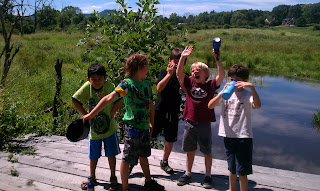

Campers went fielding with insect nets near the bike path at Amherst College. We discovered monarch butterflies, grasshoppers, crickets, spiders, moths and other animals in this meadow habitat.

We walked through the woods and found cool mushrooms, birds' egg shells and interesting flowers!

Climbing a huge mulch pile was a huge hit!

Campers got a chance to meet our live animals.

Some of whom were "spineless"...

...and others who were not!

Campers worked hard building little homes in the woods for fairies, squirrels and insects.

Campers became limnologists, exploring pond insects, mud and other aspects of freshwater science!
We hope your camper has had a wonderful experience at the Hitchcock Center summer camp! See you next year!










































